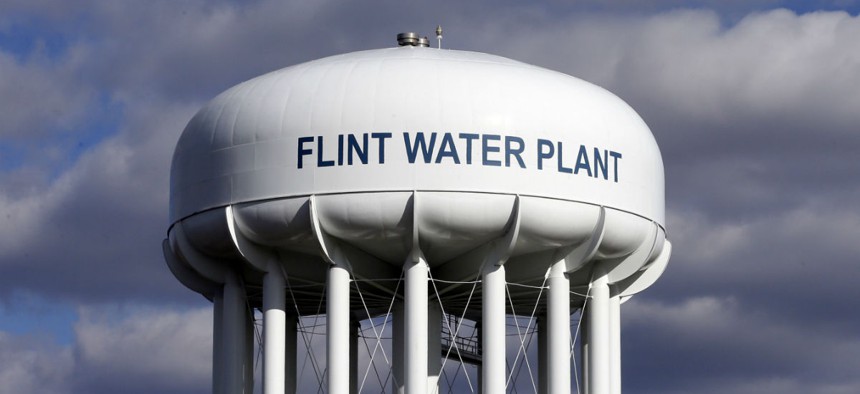
Carlos Osorio/AP
IG Faults EPA for Not Intervening Seven Months Sooner in Flint Water Crisis
Inspector general is still involved in an ongoing criminal investigation.
The Environmental Protection Agency stayed silent on water contamination in Flint, Mich., for seven months longer than it should have, according to a new report from the agency’s inspector general.
EPA’s Region Five, headquartered in Chicago, had the “authority and sufficient information” to issue an emergency order to “protect Flint residents from lead-contaminated water” as early as June 2015. They neglected to do so until January 2016. The agency declined to intervene sooner because its officials falsely, according to the IG, concluded it did not have the authority to do so.
The city of Flint switched its water source to the Flint River in April 2014. EPA Region Five employees discovered the new system lacked “necessary corrosion control” in April 2015. By June, EPA had received a sampling test result demonstrating problems, been informed no corrosion control was in place and provided information that at least four homes had lead levels in drinking water above the “action level.” It was also aware the state and local officials had not “disclosed the risks of potential lead contamination to residents.”
Under the Safe Drinking Water Act, EPA has the authority to intervene with state and local authorities when contamination may “present imminent and substantial endangerment to human health” and those local authorities “have not acted to protect the health of persons.”
“Emergency action by EPA Region 5 could have required the city and state to provide alternative water supplies to affected residents, study the extent and severity of lead contamination within the water system, or immediately begin corrective actions to reduce and eliminate lead contamination in the drinking water system,” the IG said. “However, EPA Region 5 did not intervene under SDWA Section 1431 to require immediate actions to protect human health, and the conditions in Flint continued.”
In September 2015, EPA Region Five employees formally presented the situation in Flint to headquarters staff in Washington, D.C. EPA HQ recommended the region intervene, but region officials still maintained they did not have the authority. While the region said the state was acting and headquarters deferred to the region’s judgment, “the contamination continued,” the IG said.
When EPA Administrator Gina McCarthy finally directed the Office of Enforcement and Compliance Assurance to issue an emergency order on Jan. 21, 2016, it required Flint to “continue to add corrosion inhibitors; demonstrate it has the technical, managerial and financial capacity to operate the system presently and before it switches to a new water source; and sample water quality and make data publicly available.” Susan Hedman, the Region 5 administrator, announced her resignation that day.
The IG’s management alert comes as the U.S. Attorney’s Office is completing its ongoing criminal probe into the Flint water crisis. EPA’s inspector general is participating in that investigation. To date, nine state and local officials have been criminally charged for actions related to the contamination.
In a March congressional hearing, McCarthy expressed regret for her agency’s “missed opportunities” to “put concerns about water on the radar screen” during the seven months in 2015 when agencies were talking about the threat but not intervening. But she said EPA staff were shut out by the Michigan Department of Environmental Quality which, under the law, has primary authority while EPA is charged with oversight.
On Friday, EPA spokeswoman Monica Lee reiterated that EPA was not at fault.
“EPA issued an order to the city of Flint and the state of Michigan as soon as it became apparent that the city and state were failing to address the serious problems with the Flint drinking water system,” Lee said. “We will continue to review the OIG’s findings.”
When issuing the emergency order in January, McCarthy also put forward new guidance titled “Policy on Elevation of Critical Public Health Issues.” It called for staff to “elevate” issues in which there is a “substantial threat” to public health, other authorities are unable to address the threat, normal enforcement tools are unlikely to succeed and “high and sustained public attention is possible.” EPA also boosted training on Safe Drinking Water Act authorities to headquarters and regional leaders and staff.
The IG acknowledged EPA has taken “some responsive steps” but “can do more to emphasize” the tools it has to urgently respond to crises. Auditors called for new guidance on when and how EPA should issue emergency orders and more training. EPA’s Lee said the agency has already implemented “much” of the training recommended by the IG and is “committed to updating” its SDWA guidance.







